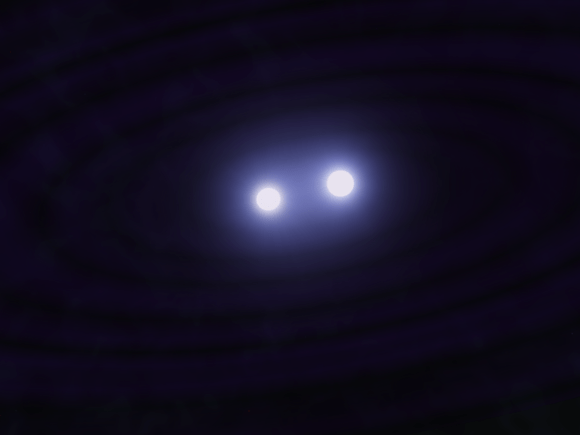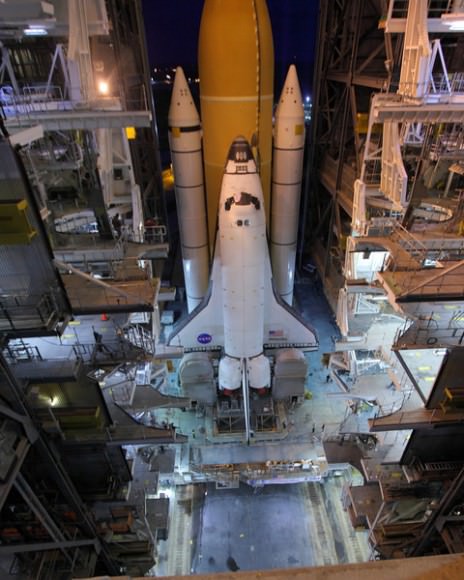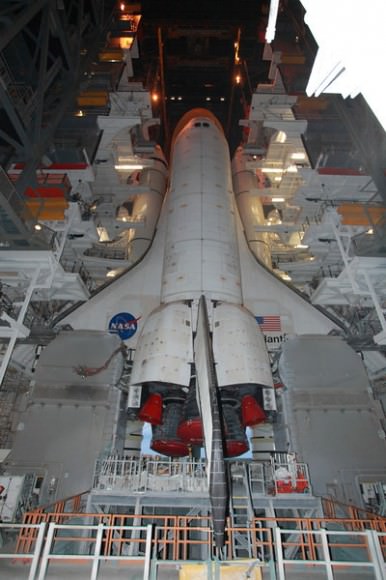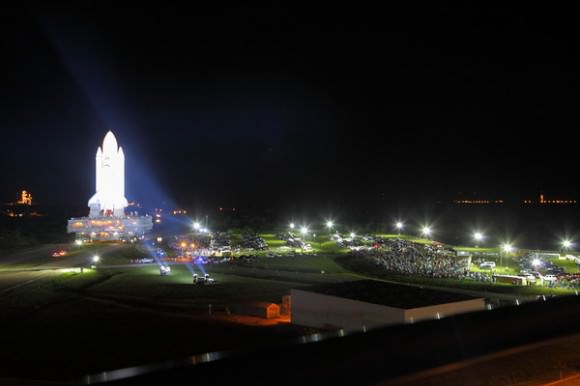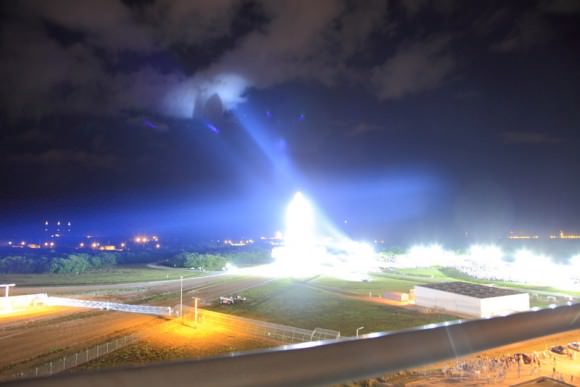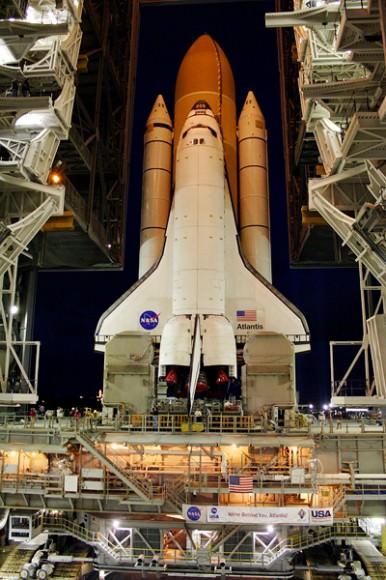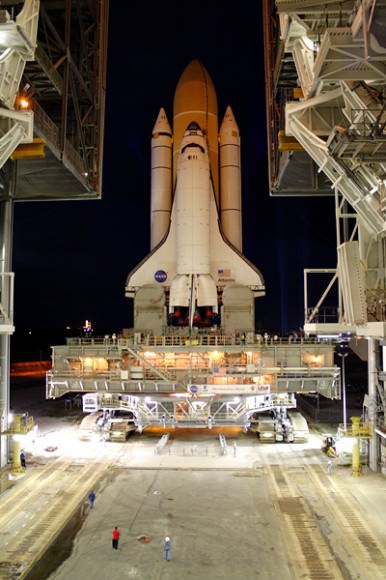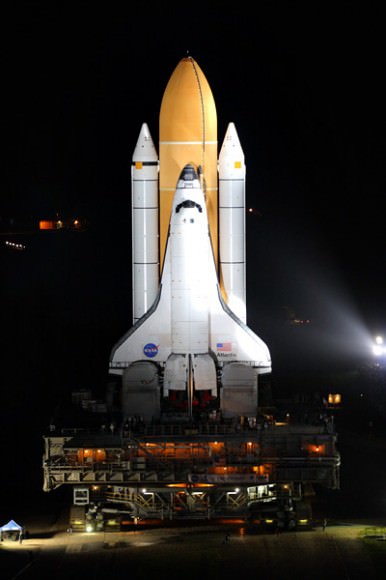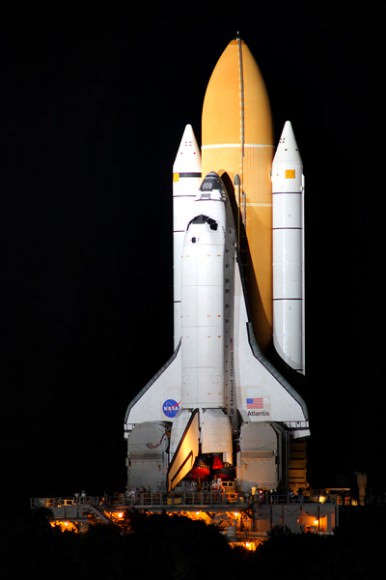What is it really like to live in space? ISS astronaut Ron Garan has been steadily communicating his experiences on board the space station since he arrived in April, with his Fragile Oasis blog, his Twitter feed and Twitpic account. Now he’s started a videoblog, to visually and verbally share even more of what it is like to live on the ISS for a long duration mission. His accompanying blog post also includes a transcript and some of the images he talks about.
Monster Prominence Erupts from Sun
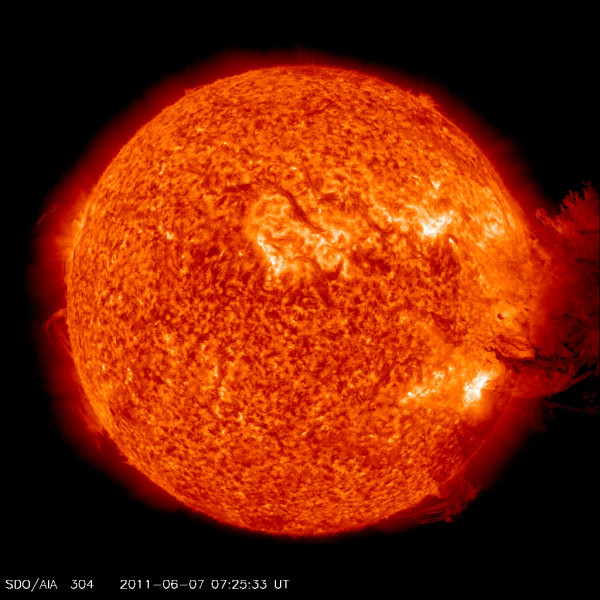
Early this morning (June 7, 2011) an amazingly massive and spectacular event took place on the Sun; a huge prominence eruption, marked by a solar flare and release of energetic particles. Daniel Pendick from the Geeked on Goddard blog described it as a “fountain of plasma that blasts out of the solar surface, spreads outward, and collapses to splat back down.”
“I’ve never seen material released like this before, such a huge amount that falls back down in such a spectacular way,” says Dr. C. Alex Young in the video. “It looks like someone just kicked a giant clod of dirt into the air and it fell back down.” Young added that this event will probably not cause any problems as far as space weather affecting Earth.
This video is courtesy NASA Goddard’sHelioviewer.org with narration by folks from The Sun Today.
Below are some still images of the event from the Solar Dynamics Observatory and (just added at 1755 UTC) a video from SDO showing the event in several different wavelengths.
These images were posted by the Camilla_SDO Twitpic feed.
[/caption]
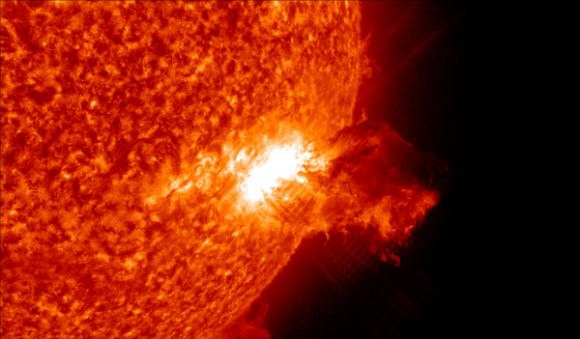
The SDO science teams says: “The Sun unleashed an M-2 (medium-sized) solar flare with a substantial coronal mass ejection (CME) on June 7 that is visually spectacular. The large cloud of particles mushroomed up and fell back down looking as if it covered an area of almost half the solar surface.”
“SDO observed the flare’s peak at 1:41 AM EST. SDO recorded these images in extreme ultraviolet light and they show a very large explosion of cool gas. It is somewhat unique because at many places in the eruption there seems to be even cooler material — at temperatures less than 80,000K.”
Update: The US National Weather Service Space Weather Prediction center has now warned that the solar flare, one of the largest to occur since December 2006, will likely lead to gemagnetic storm activity tomorrow, Wednesday.
The NWS stated: “A dramatic eruption from an otherwise unimpressive NOAA Region 1226 earlier today is expected to cause G1 (minor) to G2 (moderate) levels of geomagnetic storm activity tomorrow, June 8, beginning around 1800 UTC with the passage of a fast CME. A prompt Solar Radiation Storm reached the S1 (minor) level soon after the impulsive R1 (minor) Radio Blackout at 0641 UTC. The Solar Radiation Storm includes a significant contribution of high energy (>100 MeV) protons, the first such occurrence of an event of that type since December 2006.”
You can find updates from the Space Weather Prediction Center at this link.
STS-134 Shuttle Commander Mark Kelly appears at U2360° Concert in Seattle: Music Video

Check out this out-of-this-world surprise delivered by the rock band U2 to their concert audience at Quest Field, Seattle U2 on the night of June 4;
A video message from STS-134 Shuttle Commander Mark E. Kelly – From the Official U2 YouTube Website
According to the website, “Bono dedicated ‘Beautiful Day’ to Gabby Giffords, before asking, “Imagine a man looking down on us from 200 miles up. Looking down at our beautiful crowded planet… What would he say to us…? What is on your mind Commander Kelly?”
Kelly recorded a special message for his wife, Gabby Giffords, while he was floating inside the Cupola Observation Dome aboard the International Space Station during the STS-134 mission which landed safely on June 1 at the Kennedy Space Center.
“Hello Seattle… from the International Space Station.”
Before finishing on a line from David Bowie’s ‘Space Oddity’ : “I’m looking forward to coming home. Tell my wife I love her very much… she knows,” said Kelly
[/caption]
U2 has collaborated with NASA since their 2009 world tour to “include a dialogue between the band and the crew of the International Space Station.”
U2360° has worked with NASA and the International Space Station throughout this tour – having previously linked up with Belgian astronaut Commander Frank De Winne, Michael Barratt of NASA, Bob Thirsk of the Canadian Space Agency, Koichi Wakata of the Japan Aerospace Exploration Agency, and Gennady Padalka and Roman Romanenko of the Russian Federal Space Agency as well as Cirque du Soleil founder Guy Laliberte during his visit to the International Space Station.
“Working with U2 is atypical for NASA,” said Bill Gerstenmaier, NASA’s associate administrator for Space Operations in a NASA statement. “By combining their world tour with the space station’s out-of-this-world mission, more people — and different people than our normal target audiences — learned about the International Space Station and the important work we are doing in orbit.”
Be sure to check out this longer video version – and listen to the cheering crowd
Bono Intro to Beautiful Day with Commander Mark Kelly – U2 – Seattle, WA – June 4, 2011
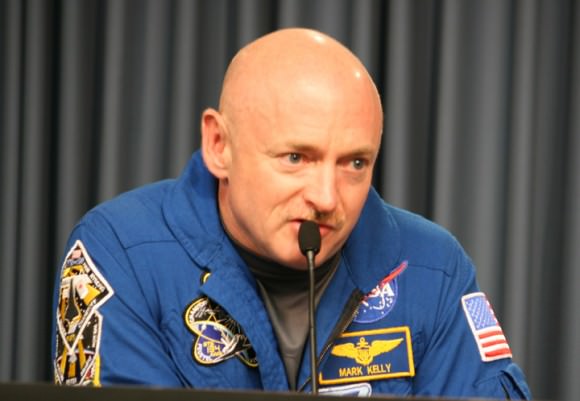
Read my features about the final mission of Endeavour, STS 134, starting here
Era of Space Shuttle Endeavour Ends with June 1 landing at the Kennedy Space Center
A White-Hot Relationship
[/caption]
Two stars have been discovered locked in a mutually-destructive embrace, a relationship that will end with both losing their individual identities as they spiral increasingly closer, eventually becoming a single hot body that is destined to quickly fizzle out.
No, we’re not talking about the cover of a Hollywood tabloid, these are two white dwarf stars 1,140 light-years away in the constellation Leo, and they are the second such pair of their kind ever to be discovered.
Astronomers at the University of Warwick in the UK have identified a binary pair of white dwarf stars named CSS 41177 that circle each other closely in an eclipsing orbit. What’s particularly unique about this pair is that both stars seem to have been stripped down to their helium layers – a feature that points at an unusually destructive history for both.
White dwarfs typically form from larger stars that have burned through their hydrogen and helium, leaving behind hot, dense cores composed of carbon and oxygen – after going through a bloated red giant phase, that is. But when stars are very close to each other, such as in the case of binary pairs, the expanding hydrogen shell from the larger one undergoing its red giant phase is stripped away by its smaller companion, which absorbs the material. Without the compression and heat from the hydrogen layer the first star cannot fuse its helium into heavier elements and is left as a helium white dwarf.
When the time comes for the smaller star to expand into a red giant, its outer layers are likewise torn away by the first star. But the first star cannot use that hydrogen, and so both are left as helium white dwarfs. The unused hydrogen is ultimately lost to the system.
It’s a case of a destructive codependent relationship on a stellar scale.
The white dwarf stars in CSS 41177 will eventually merge together in about a billion years, gaining enough mass in the process to begin fusing their combined helium, thus becoming a single star called a hot subdwarf. This period could last another 100 million years.
This discovery was made using data gathered from the Liverpool Telescope in the Canary Islands and the Gemini Telescope on Hawaii. The paper was accepted for publication in the Astrophysical Journal and is entitled A deeply eclipsing detached double helium white dwarf binary. (Authors: S. G. Parsons, T. R. Marsh, B. T. Gaensicke, A. J. Drake, D. Koester.)
Read more on SpaceRef.com.
The image above was created by Andrew Taylor, a.k.a. digital_drew. He specializes in starry-night landscapes as seen from speculative planets orbiting familiar stars in our galaxy and was kind enough to provide me with this custom binary pair image. Check out his photostream for more!
Light Blows Away Giant Molecular Clouds

[/caption]
Although they only make up about one percent of the interstellar medium, giant molecular clouds are a rather formidable thing. These dense masses of gas can reach tens of parsecs in diameter and we know them as star forming regions. But, what we didn’t know is that light from massive stars can tear them apart.
New findings presented by Dr. Elizabeth Harper-Clark and Prof. Norman Murray of the Canadian Institute for Theoretical Astrophysics (CITA) show that radiation pressure is not a thing which should be discounted. It has widely been theorized that supernovae accounted for GMC disruption, but “Even before a single star explodes as a supernova, massive stars carve out huge bubbles and limit the star formation rates in galaxies.”
Galaxies harbor stellar nurseries and, as stars are born, the galaxy evolves. It is our understanding that stellar birth occurs within giant molecular clouds where low temperatures, high density and gravity work together to ignite the stellar process. It happens at a smooth and steady rate – a pace which we surmise occurs from the outflow of energy from other stars and possibly black holes. But just what exactly is the life expectancy of a GMC?
To understand a giant molecular cloud is to understand the mass of the stars contained within it. This is key to star formation rates. “In particular, the stars within a GMC can disrupt their host and consequently quench further star formation.” says Harper-Clark. “Indeed, observations show that our own galaxy, the Milky Way, contains GMCs with extensive expanding bubbles but without supernova remnants, indicating that the GMCs are being disrupted before any supernovae occur.”
What’s happening here? Ionization and radiation pressure are blending together within the gases. Electrons are being forced out of atoms during ionization… an action which happens incredibly fast, heating up the gases and increasing pressure. The often over-looked radiation is far more subtle. “The momentum from the light is transferred to the gas atoms when light is absorbed.” says the team. “These momentum transfers add up, always pushing away from the light source, and produce the most significant effect, according to these simulations.”
The simulations performed by Harper-Clark are just the beginning of new studies. The work shows calculations of the effects of radiation pressure on GMCs and reveal they are capable of not only disrupting star-forming regions, but completely blowing them apart, cutting off further formation when about 5 to 20% of the clouds mass had been converted to stars. “The results suggest that the slow rate of star formation seen in galaxies across the Universe may be the result of radiative feedback from massive stars,” says Professor Murray, Director of CITA.
So what of supernovae? Incredibly enough, it would seem they are simply unimportant to the equation. By calculating the results both with and without star light radiation, supernova events didn’t change star formation nor did they alter the GMC. “With no radiation feedback, supernovae exploded in a dense region leading to rapid cooling. This robbed the supernovae of their most effective form of feedback, hot gas pressure.” says Dr. Harper-Clark. “When radiative feedback is included, the supernovae explode into an already evacuated (and leaky) bubble, allowing the hot gas to expand rapidly and leak away without affecting the remaining dense GMC gas. These simulations suggest that it is the light from stars that carves out nebulae, rather than the explosions at the end of their lives.”
Original Story Source: Canadian Astronomical Society More information on Dr. Harper-Clark’s work can be found here.
How High Do Planes Fly
[/caption]
Have you ever asked how high do planes fly? The answer is easy to understand when you remember how flight for aircraft works. The first thing to know is that air is a fluid just like water. So it works under the same rules. Any object that moves in a fluid is under the influence of four forces, drag, lift, weight, and thrust. The net total has to be positive so that the influence of thrust and lift keeps a plane in the air. Thrust and lift depend on the density of the air. So it is easier to achieve the ideal lift and thrust at higher elevations than lower elevations. So how high a plane flies is not fixed except for the limit of the vacuum of space of where the atmosphere becomes too thin for aerodynamics to work.
Lift and thrust are the main forces that make flight possible. As long as they are greater than weight or drag, plane will fly. Thrust is the forward acceleration produced by a plane’s engine. The less dense the air the more thrust a plane must produce to create the needed lift. The full explanation is pretty complicated but the best way to put is that every plane has a maximum condition it achieves to fly. This maximum is the best possible combination of density, speed, and lift to fly the plane. That is why the height a plane can fly can vary so much. It depends on the needs of the plane.
A good example is commercial turbo jets. Turbo jets fly below the speed of sound. The also weigh a lot. In order to reach optimal flight conditions and fly at speeds convenient enough to make air travel profitable, most commercial planes fly at 30,000 feet. This is high enough that a plane has the least amount of drag and can reach the top speed its engines can produce safely. Supersonic craft like fighter jets and spy planes can fly much higher. This is because they design of the plane makes it easier for the plane to resist drag and produce greater thrust to compensate for the thinner air.
So we see that how high a plane can fly is determined by its use, the drag, the lift, thrust, and weight. We also know that a planes absolute limit will be where air becomes too thin to act like a fluid which is the uppermost level of the atmosphere. Right now scientist are looking to take advantage of this upper level of the atmosphere to help planes fly even faster. However there are still barriers such as friction and engine design.
We have written many articles about airplanes for Universe Today. Here’s an article about the largest airplane, and here’s an article about pictures of airplanes.
If you’d like more info on airplanes, check out these articles from How Stuff Works. Here’s an article about How Airplanes Fly.
We’ve also recorded an entire episode of Astronomy Cast all GPS Navigation. Listen here, Episode 212: GPS Navigation.
Sources:
NASA
How Stuff Works
Thierry Legault’s Incredible Ground-Based Views of Endeavour’s Final Flight
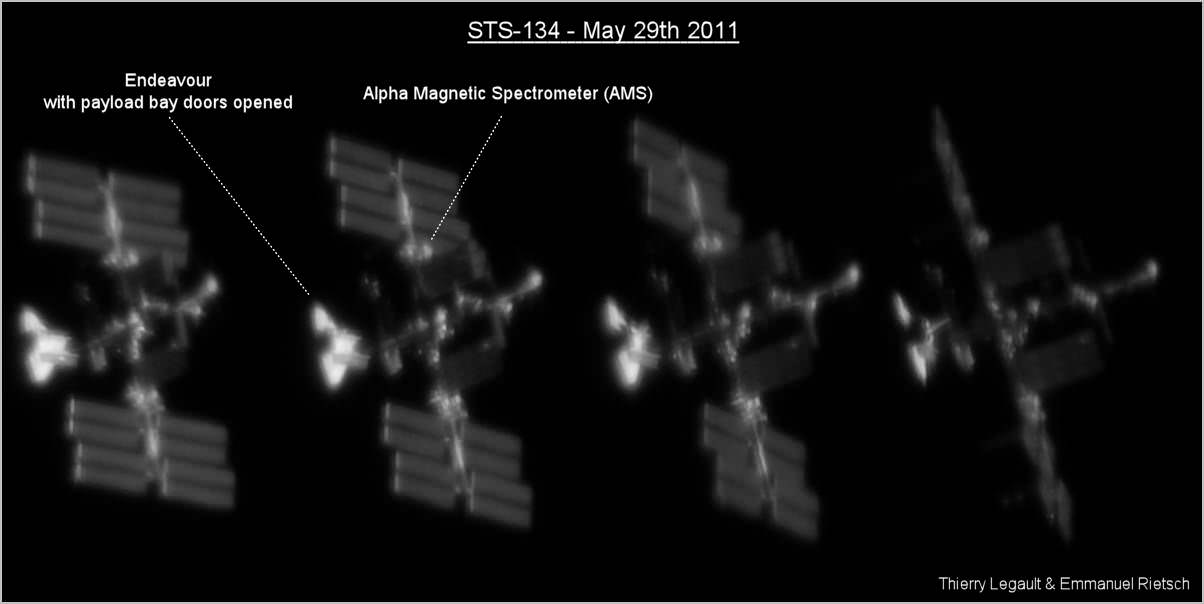
[/caption]
Award-winning French astrophotographer Thierry Legault traveled through Germany, France and Spain during Endeavour’s final mission to find clear skies and good seeing to capture the shuttle’s voyage to the International Space Station. While he told us it wasn’t easy, the results are incredible! The visible detail of the shuttle and parts of the International Space Stations is absolutely amazing. You can see the newly installed Alpha Magnetic Spectrometer in one shot, as well as the open payload bay doors on Endeavour in another. The video Legault shot is available on his website, and he has unique 3-D versions as well.
Below are some of his trademark views of transits of the Sun by ISS and Endeavour, with one showing the shuttle just before it docked to the station.
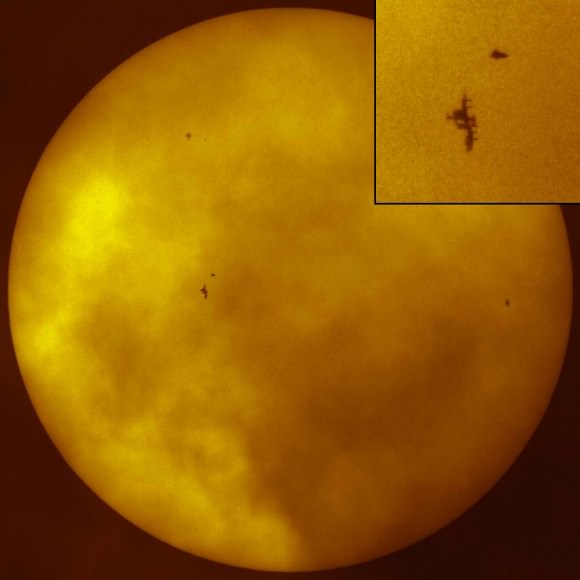
Legault told us he was chasing the shuttle and the station from different parts of Europe, however because of weather problems (clouds and turbulence) he was not very happy with the results. But this image is stunning anyway even though clouds dimmed available light by more than 100 times, Legault said. What is perhaps most amazing is that the transit time for this pass in front of the Sun was 0.7 seconds!
Here’s a less cloudy view taken on May 25:
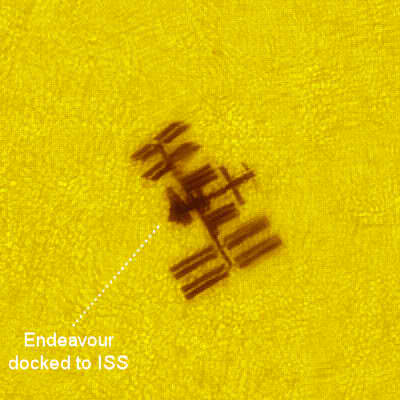
And the full view for reference. This transit was only a half second!
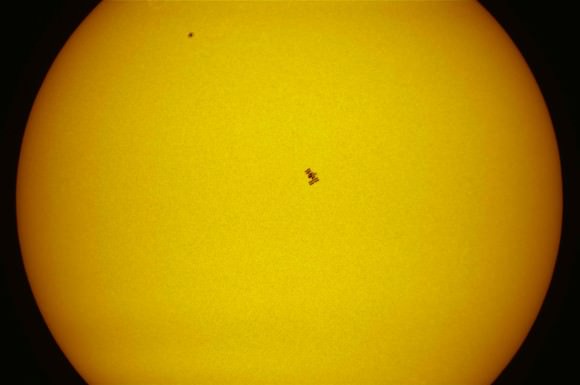

All transit images were taken with Takahashi TOA-150 6″ apochromatic refractor (focal length 2400mm and 3600mm) on EM-400 mount, Baader Herschel wedge. Nikon D3X at 1/8000s, 100 ISO, working in continuous shooting at 5 frames per second during 5 seconds.
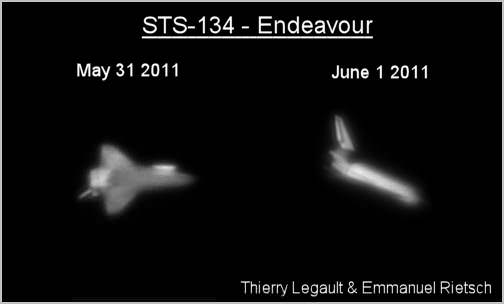
Here are frames from videos taken by Legault and fellow astrophotographer Emmanual Rietsch just prior to the deorbit burn for landing on June 1. The video of these shots, as well as more images are also available on Legault’s website.
Thanks to Thierry for sending Universe Today these amazing images and allowing us to post them!
Copenhagen Suborbitals Launch Videos
Congrats to Copenhagen Suborbitals! On Friday, a group of amateur rocketeers successfully launched the world’s first amateur-built rocket made for human space travel. The home-made HEAT-1X rocket with the Tycho Brahe capsule reached an altitude of 2.8 kilometers, launching from its floating ‘Sputnik’ platform in the Baltic Sea off the east coast of the Danish island of Bornholm. The builders, Peter Madsen, Kristian von Bengtson and their team, hoped the craft would fly 15 to 16 kilometers into the sky on its maiden voyage, but they said they would also be happy if it launched at all. And the rocket shot almost straight up in a tremendous milestone for the amateur group which hopes to send people into space on a shoestring.
Below are some great videos, including a “pilot’s point of view” – what the view looked like from the single-passenger capsule where the passenger will stand up and have a full view through a polymer plexiglas-dome so that the person can see and experience the entire ballistic ride.
Astronomy Without A Telescope – Enough With The Dark Already

[/caption]
The recent WiggleZ galaxy survey data further confirming that the universe is expanding with a uniform acceleration prompted a lot of ‘astronomers confirm dark energy’ headlines and a lot of heavy sighs from those preferring not to have the universe described in ten words or less.
I mean how the heck did ‘dark energy’ ever become shorthand for ‘the universe is expanding with a uniform acceleration’?
These ‘dark energy confirmed’ headlines risk developing a popular view that the universe is some kind of balloon that you have to pump energy into to make it expand. This is not an appropriate interpretation of the dark energy concept – which only came into common use after 1998 when Type 1a supernova data were announced, suggesting an accelerating expansion of the universe.
It was widely accepted well before then that the universe was expanding. A prevalent view before 1998 was that expansion might be driven by the outward momentum of the universe’s contents – a momentum possibly established from the initial cosmic inflation event that followed the Big Bang.
Current thinking on the expansion of the universe does not associate its expansion to the momentum of its contents. Instead the universe is thought of as raisin toast dough which expands in an oven – not because the raisins are pushing the dough outwards, but because the dough itself expands and as a consequence the distance between the raisins (i.e. galaxies etc) increases.
It’s not a perfect analogy since space-time is not a substance – and, at the level of a universe, the heat of the oven equates to the input of energy out of nowhere – and being thermal energy, it’s not dark.
Alternatively, you can model the universe as a perfect fluid where you think of dark energy as a negative pressure (since a positive pressure would compress the fluid). A negative pressure does not obviously require additional contents to be pumped into the fluid universe, although the physical nature of a ‘negative pressure’ in this context is yet to be explained.
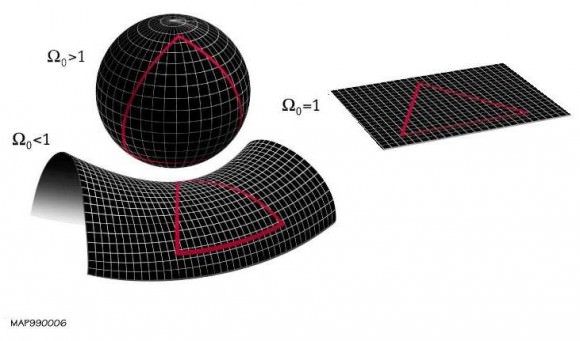
The requirement for dark energy in standard model cosmology is to sustain the observable flat geometry of space – which is presumed to be sustained by the mass-energy contents of the universe. Too much mass-energy should give a spherical shape to space, while too little mass-energy should give a hyperboloid shape.
So, since the universe is flat – and stays flat in the face of accelerating expansion, there must be a substantial ‘dark’ (i.e. undetectable) component. And it seems to be a component that grows as the universe increases in volume, in order to sustain that flat geometry – at least in current era of the universe’s evolution.
It is called ‘energy’ as it is evenly distributed (i.e. not prone to clumping, like dark matter), but otherwise it has no analogous properties with any form of energy that we know about.
More significantly, from this perspective, the primary requirement for dark energy is not as a driver of expansion, but as a hypothetical entity required to sustain the flatness of space in the face of expansion. This line of thinking then begs the question of just what does drive the accelerating expansion of the universe. And an appropriate answer to that question is – we haven’t a clue.
A plausible mechanism that accounts for the input of energy out of nowhere – and a plausible form of energy that is both invisible and that somehow generates the production of more space-time volume are all required to support the view that dark energy underlies the universe’s accelerating expansion.
Not saying it’s impossible, but no way has anyone confirmed that dark energy is real. Our flat universe is expanding with a uniform acceleration. For now, that is the news story.
Further reading:
Expansion of the universe
Shape of the universe
Last Ever Shuttle Journeys out to the Launch Pad; Photo Gallery
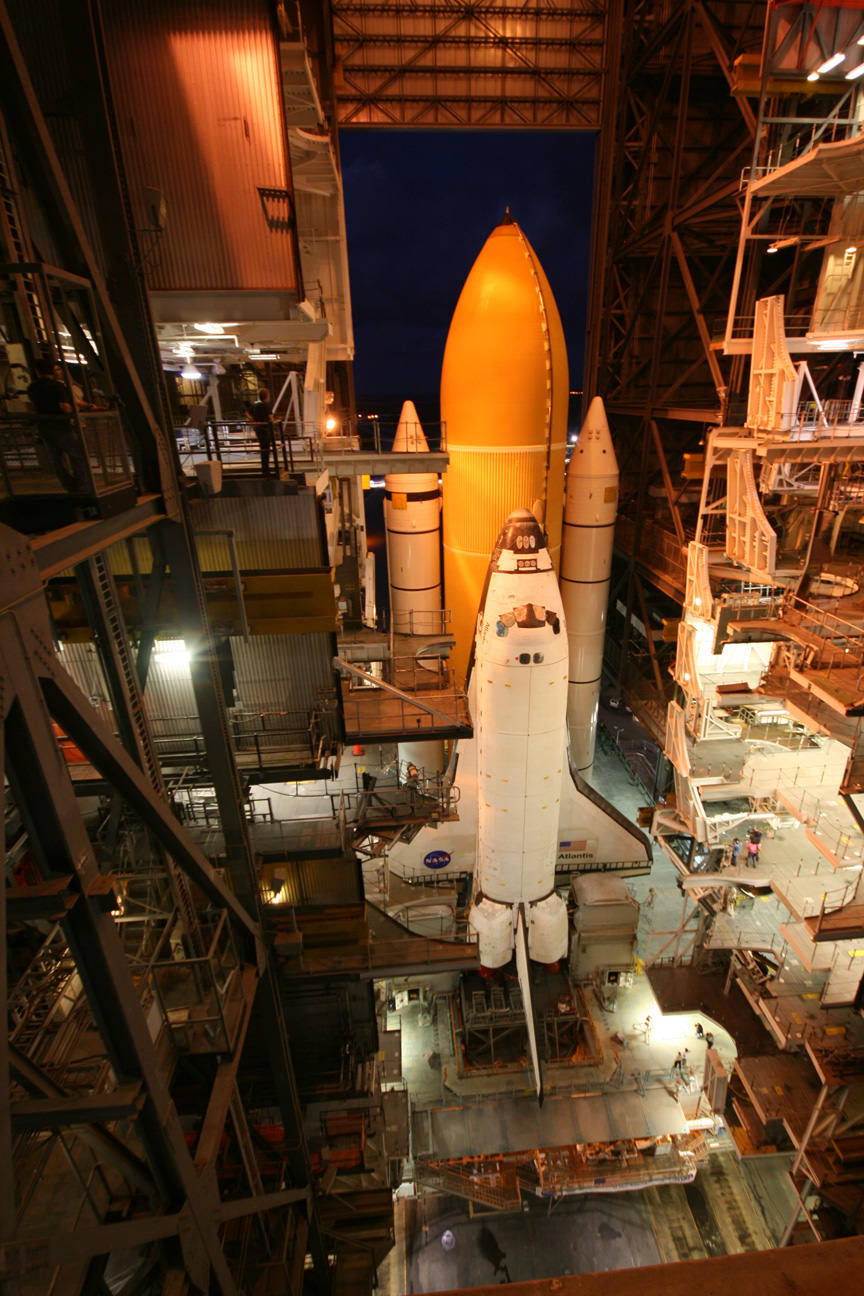
[/caption]KENNEDY SPACE CENTER – The last shuttle that will ever blast to space has journeyed from the cavernous Vehicle Assembly Building out to the launch pad at NASA’s Kennedy Space Center (KSC) in Florida in anticipation of liftoff on July 8 at 11:38 a.m.
It was a proud and bittersweet moment for all the shuttle team members from top to bottom as Space Shuttle Atlantis was rolling out overnight to Launch Pad 39 A, at the same time that Space Shuttle Endeavour was plunging into Earth’s atmosphere for the scorching reentry and landing back at the shuttle landing strip at KSC.
Thousands of NASA and contractor employees and their families had been given special passes to witness the dramatic nighttime sojourn of Atlantis in a morale booster event as she emerged from inside the VAB on her way to the pad for what will be the grand finale of the 30 year long Space Shuttle Program.
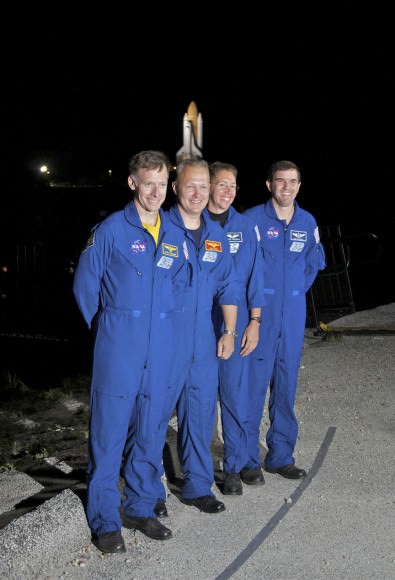
STS-135 Commander Chris Ferguson, left, Pilot Doug Hurley, and Mission Specialists Sandy Magnus and Rex Walheim talk to media as their vehicle, space shuttle Atlantis, makes its final journey from the Vehicle Assembly Building to Launch Pad 39A at KSC in Florida.
Credit: Chase Clark
The 12 day STS-135 mission will deliver the Raffaello logistic module to the International Space Station (ISS) which is loaded with critical spare parts, crew supplies and science gear that will be transferred to the massive orbiting outpost. Raffaello is a multipurpose logistics module built in Italy.
The STS-135 mission is a bonus for the shuttle program and was only officially added to the manifest in January 2011 as NASA sought funding from the Obama Administration and the US Congress.
The all veteran four person crew is led by Shuttle Commander Christopher Ferguson. He is joined by Pilot Doug Hurley and Mission Specialists Sandy Magnus and Rex Walheim.
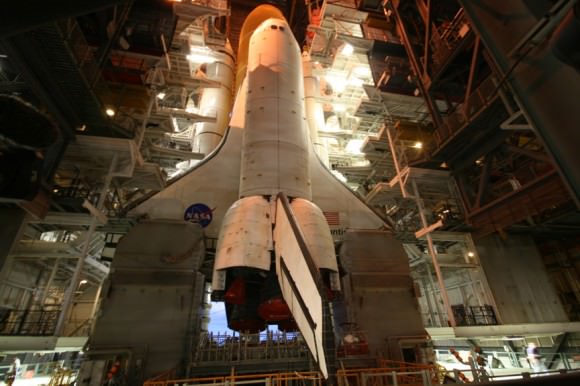
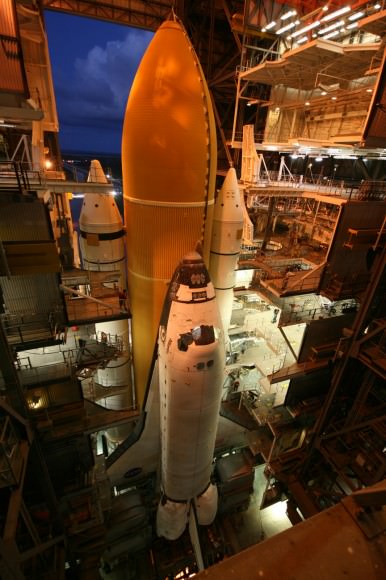
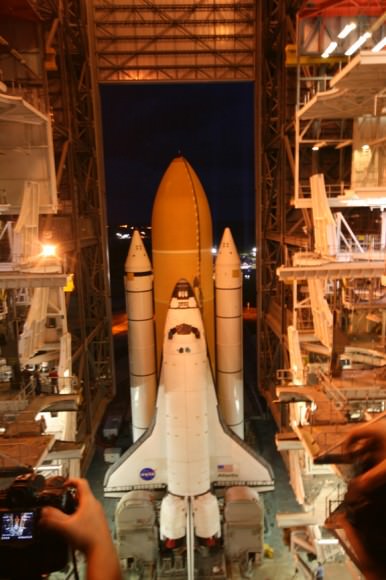
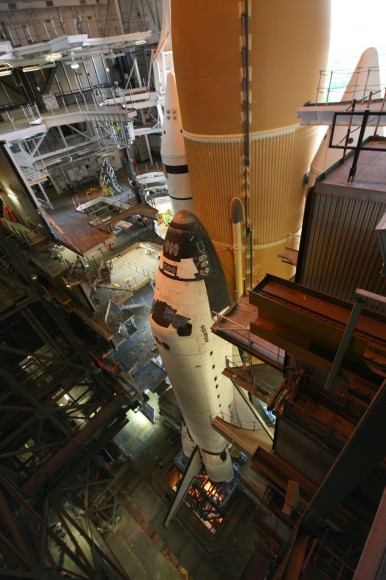
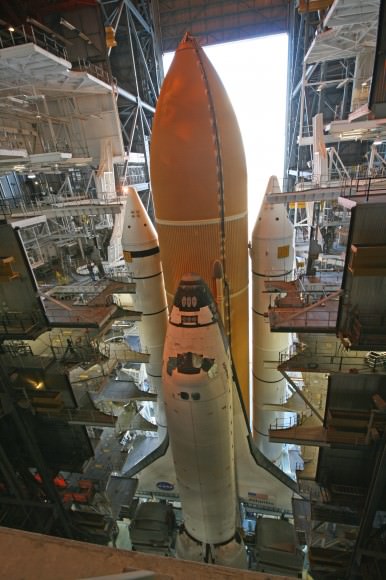
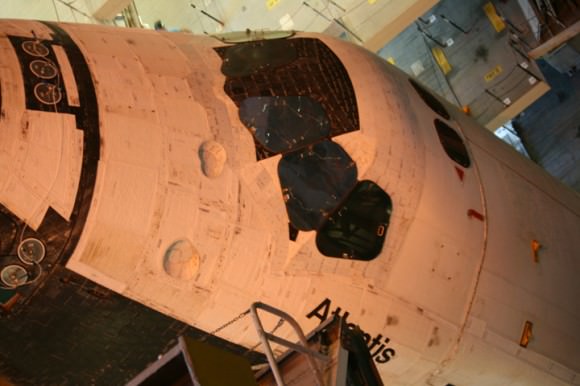
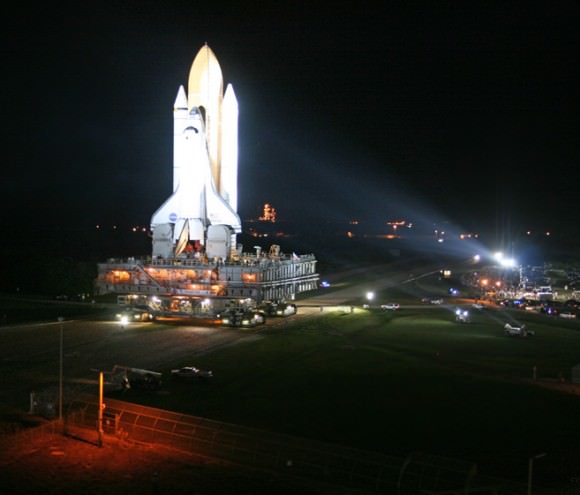
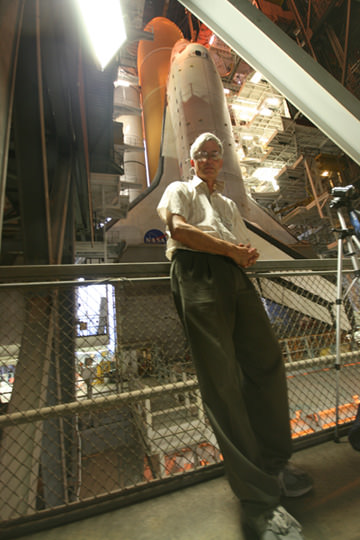
Photos from Alan Walters for Universe Today: awaltersphoto.com
Photos from Mike Deep for Universe Today
Read my prior features about the Final Shuttle mission, STS-135, here:
Atlantis Goes Vertical for the Last Time
Atlantis Rolls to Vehicle Assembly Building with Final Space Shuttle Crew for July 8 Blastoff
Read my features about the final mission of Endeavour, STS 134, starting here
Era of Space Shuttle Endeavour Ends with June 1 landing at the Kennedy Space Center

